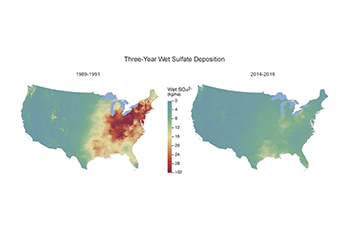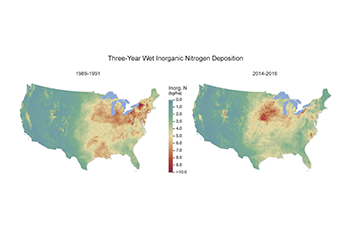Progress Report
Acid Deposition
Acid Deposition Figures
Last updated: 05/2018
Related Figures



Highlights
Wet Sulfate Deposition
- All areas of the eastern United States have shown significant improvement, with an overall 66 percent reduction in wet sulfate deposition from 1989–1991 to 2014–2016.
- Between 1989-1991 and 2014-2016, the Northeast and Mid-Atlantic experienced the largest reductions in wet sulfate deposition, of 69 percent and 71 percent, respectively.
- A decrease in both SO₂ emissions from sources in the Ohio River Valley and the formation of sulfates that are transported long distances have resulted in reduced sulfate deposition in the Northeast. The sulfate reductions documented in the region, particularly across New England and portions of New York, were also affected by lowered SO₂ emissions in eastern Canada.1
Wet Inorganic Nitrogen Deposition
- Wet deposition of inorganic nitrogen decreased an average of 35 percent in the Mid-Atlantic and Northeast but decreased only 15 percent in the Midwest from 1989–1991 to 2014–2016. Smaller reductions in wet deposition of inorganic nitrogen deposition in the Midwest are attributed to a 15 percent increase in wet deposition of reduced nitrogen (NH₄+) over the same time period.
- Reductions in nitrogen deposition recorded since the early 1990s have been less pronounced than those for sulfur. Emissions from other source categories (e.g., mobile sources, agriculture, and manufacturing) contribute to air concentrations and deposition of nitrogen.
Regional Trends in Deposition
- The reduction in total sulfur deposition (wet plus dry) has been of similar magnitude to that of wet deposition with an overall average reduction of 88 percent from 1989–1991 to 2014–2016.
- Decreases in dry and total inorganic nitrogen deposition have generally been greater than that of wet deposition, with average reductions of 62 percent and 71 percent, respectively. In contrast, wet deposition from inorganic nitrogen decreased by an average of 26 percent from 1989–1991 to 2014–2016.
Analysis and Background Information
Acid Deposition
As SO₂ and NOₓ gases react in the atmosphere with water, oxygen, and other chemicals, they form acidic compounds that are deposited to the earth's surface in the form of wet and dry acid deposition.
Long-term monitoring network data show significant improvements in the primary indicators of acid deposition. For example, wet sulfate deposition (sulfate that falls to the earth through rain, snow, and other precipitation) has decreased in much of the Ohio River Valley and Northeastern United States due to SO₂ emission reductions achieved through implementation of the Acid Rain Program (ARP), the Clean Air Interstate Rule (CAIR) and the Cross-State Air Pollution Rule (CSAPR). Some of the most dramatic reductions have occurred in the mid-Appalachian region, including Maryland, New York, West Virginia, Virginia, and most of Pennsylvania. Along with wet sulfate deposition, precipitation acidity, expressed as hydrogen ion (H+ or pH) concentration, has also decreased by similar percentages.
Reductions in nitrogen deposition compared to the early 1990s have been less pronounced than those for sulfur. As noted earlier, emissions from source categories other than ARP and CSAPR sources contribute to changes in air concentrations and deposition of nitrogen.
Monitoring Networks
The Clean Air Status and Trends Network (CASTNET) provides long-term monitoring of regional air quality to determine trends in atmospheric concentrations and deposition of nitrogen, sulfur, and ozone in order to evaluate the effectiveness of national and regional air pollution control programs. CASTNET now operates more than 90 regional sites throughout the contiguous United States, Alaska, and Canada. Sites are located in areas where urban influences are minimal.
The National Atmospheric Deposition Program/National Trends Network (NADP/NTN) is a nationwide, long-term network tracking the chemistry of precipitation. The NADP/NTN provides concentration and wet deposition data on hydrogen ion (acidity as pH), sulfate, nitrate, ammonium, chloride, and base cations. The NADP/NTN has grown to more than 250 sites spanning the United States, Canada, Puerto Rico, and the Virgin Islands.
Together, these complementary networks provide long-term data needed to estimate spatial patterns and temporal trends in total deposition.
More Information
- Learn more about acid rain
- Clean Air Status and Trends Network (CASTNET)
- National Atmospheric Deposition Program (NADP) Exit
References
- Government of Canada, Environment Canada. (2017). Canada-United States Air Quality Agreement Progress Report 2016. ISSN: 1910–5223: Cat. No.: En85-1E-PDF.